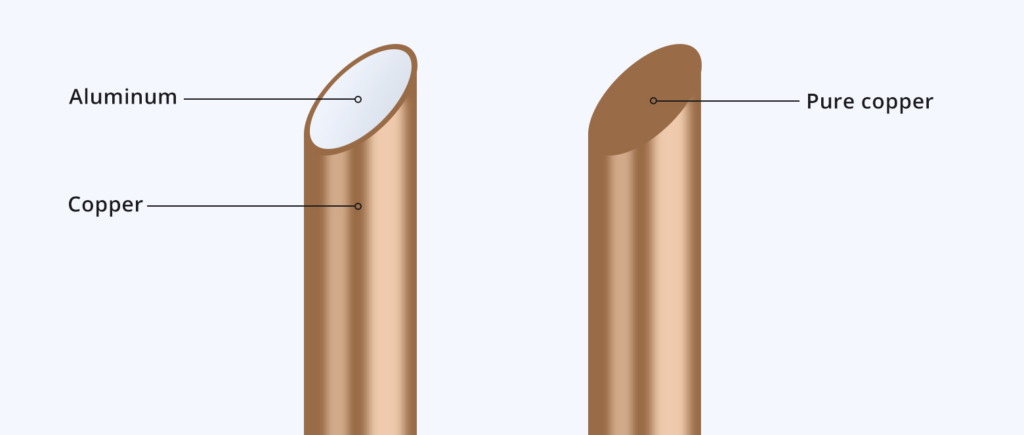
For audiophiles and home theater enthusiasts, the debate between oxygen-free copper (OFC) and copper-clad aluminum (CCA) speaker cables is more than just a technical discussion—it’s about maximizing sound quality, durability, and value. This article breaks down their differences, focusing on how they impact speaker performance, and helps you decide which material suits your needs.
I. Introduction
Speaker cables are the lifelines of any audio system, transmitting signals from amplifiers to speakers. While OFC and CCA are common materials, their performance varies drastically. OFC boasts 99.99% pure copper, while CCA uses an aluminum core wrapped in a thin copper layer. This guide compares their pros and cons, focusing on speaker cable applications, to help you make an informed choice.
II. What’s the Difference Between OFC and CCA?
1. Material Composition
- OFC: Made from 99.99% pure copper, OFC eliminates oxygen impurities during manufacturing, ensuring minimal resistance and oxidation over time.
- CCA: Combines a lightweight aluminum core (85-90% of the cable) with a superficial copper coating (10-15% by weight).
2. Key Performance Metrics
- Conductivity: OFC’s conductivity is ≈101% IACS (International Annealed Copper Standard), while CCA drops to ≈61% due to aluminum’s inferior conductivity.
- Durability: OFC resists corrosion and maintains flexibility, whereas CCA’s aluminum core can oxidize at connection points, leading to signal degradation.
- Weight: CCA is 50% lighter than OFC but stiffer, making it harder to route in tight spaces.
-
Parameter OFC CCA Technical Implications Conductivity (IACS%) 101% 61% OFC’s near-pure copper minimizes signal loss; CCA requires thicker gauges to compensate.
Density (kg/dm³) 8.93 3.62 CCA is lighter but offers weaker conductivity per unit volume. Resistivity (Ω·mm²/m) 0.0171 0.0255 CCA’s higher resistivity causes greater power loss over long distances.
Tensile Strength (N/mm²) 220–300 150–230 OFC’s flexibility suits frequent adjustments; CCA’s aluminum core risks cracking.
Cost High (3–4× copper price) Low (30–50% cheaper) CCA suits budget projects but may incur long-term maintenance costs.
Oxidation Risk Very low (oxygen-free process) High (aluminum core corrodes) CCA joints degrade faster, requiring periodic cleaning to prevent signal dropouts.
3. Cost Comparison
CCA cables are 40-60% cheaper than OFC, appealing to budget-conscious buyers. However, OFC’s longevity often justifies its higher upfront cost.
III. Why Speaker Cables Matter in the OFC vs. CCA Debate
1. Signal Loss Over Distance
Long cable runs amplify resistance-related power loss. For example:
- A 20-foot CCA cable loses ≈12% of the amplifier’s power.
- The same length in OFC loses only ≈5%, preserving dynamic range and clarity.
This makes OFC ideal for large rooms or setups with speakers far from the amplifier.
2. Impact on Sound Quality
- OFC: Delivers precise highs, detailed mids, and tight bass due to minimal distortion. Audiophiles report improved instrument separation in complex tracks (e.g., classical or jazz).
- CCA: Struggles with high-frequency “smearing” and muddier bass, especially in high-wattage systems.
3. Durability in Speaker Applications
OFC withstands frequent plugging/unplugging, while CCA’s brittle aluminum core can crack under bending stress. For permanent installations, OFC is more reliable.
IV. When to Use OFC vs. CCA Speaker Cables
1. Choose OFC If…
- You prioritize high-fidelity audio (e.g., vinyl setups, studio monitors).
- Your system uses amplifiers over 100W per channel.
- You need cables longer than 10 feet.
Example: Chuanpu Cable’s OFC Fengxu Series offers audiophile-grade performance with 12AWG pure copper strands, ideal for critical listening environments.
2. Choose CCA If…
- Budget is tight, and cable runs are short (<10 feet).
- Used in low-power systems (e.g., desktop speakers or budget home theaters).
V. Myths vs. Facts
- Myth: “All OFC cables are overkill for casual listeners.”
Fact: Even entry-level OFC (e.g., Chuanpu’s bulk OFC options) improves longevity and signal integrity compared to CCA. - Myth: “CCA is just as good for bass-heavy music.”
Fact: CCA’s higher resistance can dampen bass impact and reduce transient response.
VI. How to Spot Fake OFC Speaker Cables
- Magnet Test: OFC is non-magnetic. If a cable reacts to a magnet, it likely contains steel or aluminum (common in CCA).
- Weight Check: OFC is ≈3x denser than CCA. A 10ft 14AWG OFC cable weighs ~1.2 lbs, while CCA weighs ~0.4 lbs.
VII. Conclusion
- For Critical Listening: Invest in OFC speaker cables like Chuanpu’s Fengxu Series to unlock your system’s full potential.
- For Budget Projects: Use CCA cautiously, keeping runs short and avoiding high-power systems.
- Pro Tip: Bulk OFC cables from suppliers like Chuanpu Cable provide a cost-effective balance of quality and value for DIY installations.